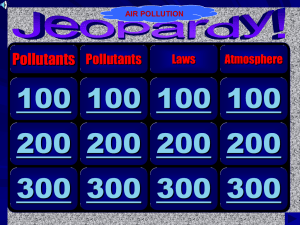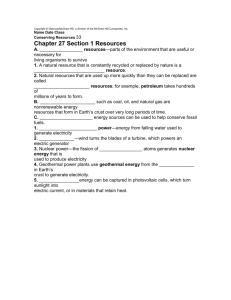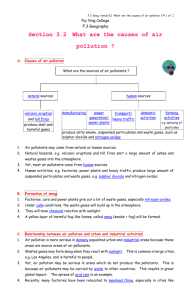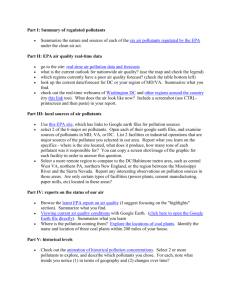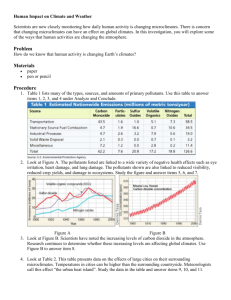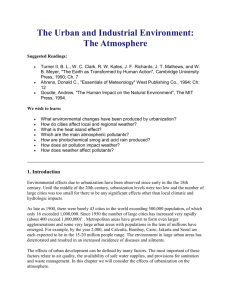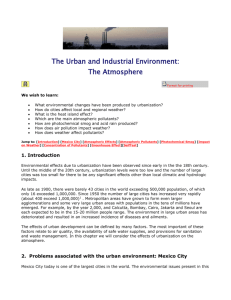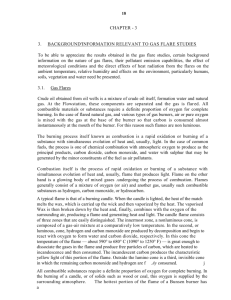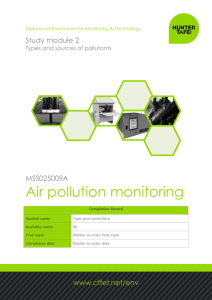LEARNING OBJECTIVES
advertisement
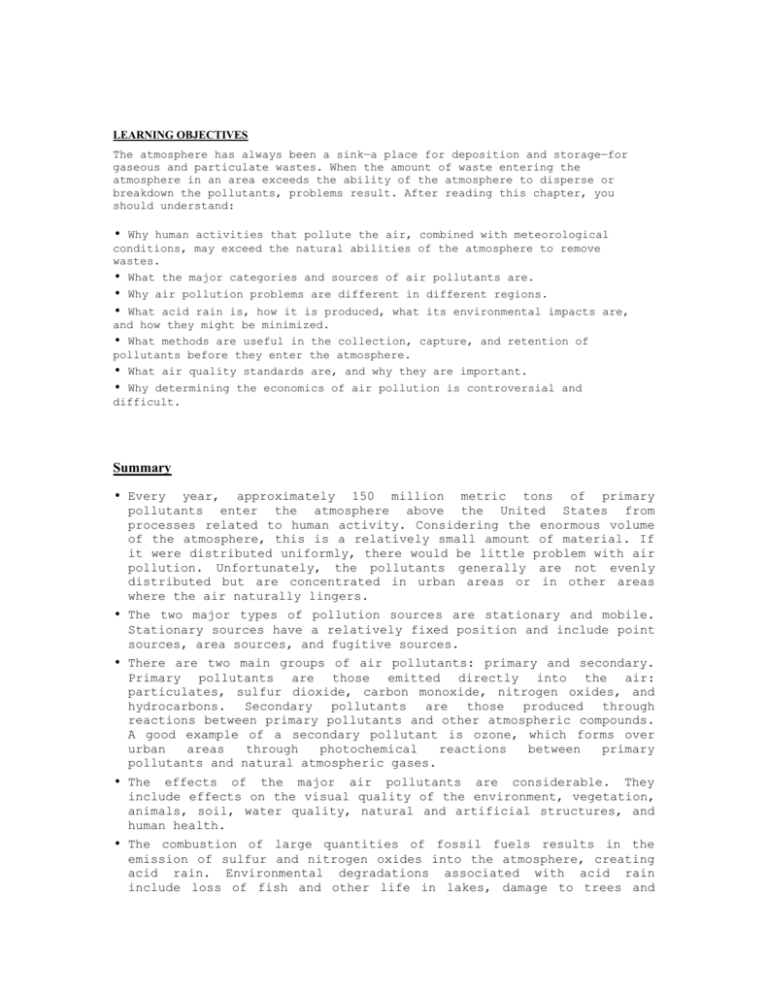
LEARNING OBJECTIVES The atmosphere has always been a sink—a place for deposition and storage—for gaseous and particulate wastes. When the amount of waste entering the atmosphere in an area exceeds the ability of the atmosphere to disperse or breakdown the pollutants, problems result. After reading this chapter, you should understand: • Why human activities that pollute the air, combined with meteorological conditions, may exceed the natural abilities of the atmosphere to remove wastes. • What the major categories and sources of air pollutants are. • • Why air pollution problems are different in different regions. What acid rain is, how it is produced, what its environmental impacts are, and how they might be minimized. • What methods are useful in the collection, capture, and retention of pollutants before they enter the atmosphere. • What air quality standards are, and why they are important. • Why determining the economics of air pollution is controversial and difficult. Summary • Every year, approximately 150 million metric tons of primary pollutants enter the atmosphere above the United States from processes related to human activity. Considering the enormous volume of the atmosphere, this is a relatively small amount of material. If it were distributed uniformly, there would be little problem with air pollution. Unfortunately, the pollutants generally are not evenly distributed but are concentrated in urban areas or in other areas where the air naturally lingers. • The two major types of pollution sources are stationary and mobile. Stationary sources have a relatively fixed position and include point sources, area sources, and fugitive sources. • There are two main groups of air pollutants: primary and secondary. Primary pollutants are those emitted directly into the air: particulates, sulfur dioxide, carbon monoxide, nitrogen oxides, and hydrocarbons. Secondary pollutants are those produced through reactions between primary pollutants and other atmospheric compounds. A good example of a secondary pollutant is ozone, which forms over urban areas through photochemical reactions between primary pollutants and natural atmospheric gases. • The effects of the major air pollutants are considerable. They include effects on the visual quality of the environment, vegetation, animals, soil, water quality, natural and artificial structures, and human health. • The combustion of large quantities of fossil fuels results in the emission of sulfur and nitrogen oxides into the atmosphere, creating acid rain. Environmental degradations associated with acid rain include loss of fish and other life in lakes, damage to trees and other plants, leaching of nutrients from soils, and damage to stone statues and buildings in urban areas. • There are two major types of smog: photochemical and sulfurous. Each type of smog brings particular environmental problems that vary with geographic region, time of year, and local urban conditions. • Meteorological conditions greatly affect whether polluted air is a problem in an urban area. In particular, restricted circulation in the lower atmosphere associated with temperature inversion layers may lead to pollution events. • There are two major types of smog: photochemical and sulfurous. Each type of smog brings particular environmental problems that vary with geographic region, time of year, and local urban conditions. • From an environmental viewpoint, the preferred method of reducing the emission of air pollutants practice energy efficiency of fossil fuels are burned. alternative energy sources, emit air pollutants. produced from burning fossil fuels is to and conservation so that smaller amounts Another option is to increase the use of such as solar and wind power, that do not • Methods to control air pollution are tailored to specific sources and types of pollutants. These methods vary from settling chambers for particulates to scrubbers that use lime to remove sulfur before it enters the atmosphere. • Efforts to reduce air pollution in urban regions center on automobiles, buses, and other vehicles, because they account for most of the pollutants that enter the urban atmosphere. • Emissions of air pollutants in the United States are decreasing. In developing countries, air pollution in large urban centers is often a serious problem. • Air quality in U.S. urban areas is usually reported in terms of whether the quality is good, moderate, unhealthy for sensitive groups, unhealthy, very unhealthy, or hazardous. These levels are defined in terms of the Air Quality Index (AQI). • The relationships between emission control and environmental cost are complex. The minimum total cost is a compromise between capital costs to control pollutants and losses or damages resulting from pollution. If additional controls are necessary to lower the pollution to a more acceptable level, additional costs are incurred. Beyond a certain level of pollution abatement, these costs can increase rapidly.



